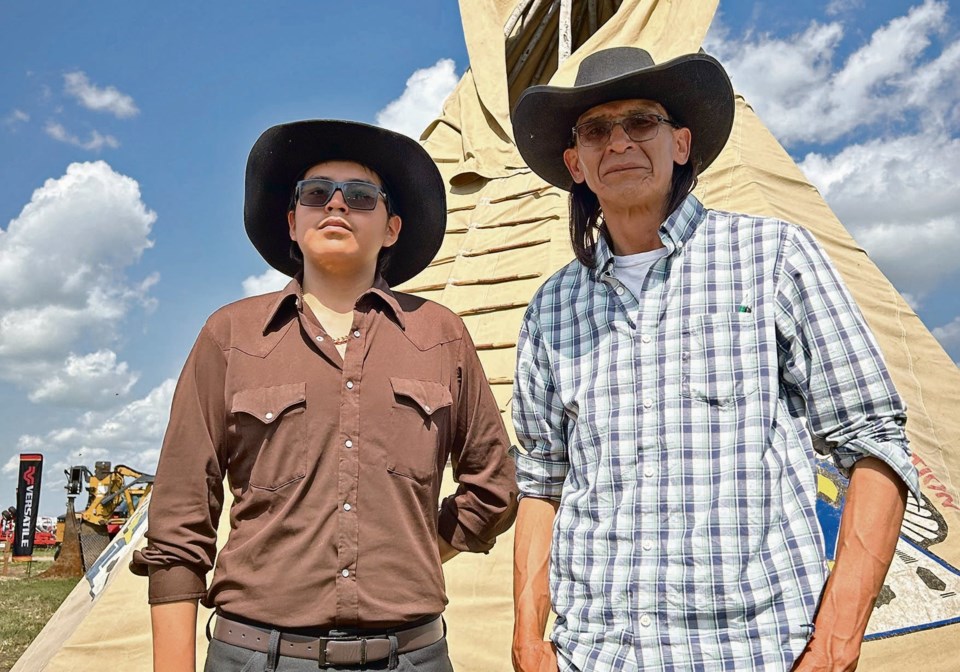LANGHAM — Like a lot of young men in rural communities, Kobe Wolf Child is proud to be a ranch hand.
It’s the perfect lifestyle for the 20 year old.
“The outdoors, always walking, riding horses, 小蓝视频 around animals,” is how Wolf Child, a member of the Blood Indian Reservation at Cardston, Alta., describes what he loves about his job.
You might think that Kobe would be surrounded by fellow Indigenous farm and ranch hands working for Indigenous agriculture operations across the Prairies. After all, collectively First Nations own more farmland than anybody else in Canada.
But you’d be wrong. There are few Indigenous farms compared to the amount of farmland owned by bands. There are far fewer Indigenous workers in agriculture than their share of the rural population would seem to warrant.
On his large reserve, Wolf Child’s employment on a farm is “not common.” Nor is it common for Indigenous people like his employer, Warren Many Grey Horses, to operate substantial farms.
That’s a tragedy, but a great opportunity, for Indigenous communities, say some Indigenous producers.
“It brought me to where I am now,” said Terry Lerat of the Cowessess First Nation in the Qu’appelle Valley near Broadview, Sask. His parents operated a mixed farm and raised him and his siblings in the farming lifestyle. He admits to grumbling about having to do chores every day when he got home from school, but now believes that time was the best in his life, one that taught lessons about hard work, not complaining and creating your own economic self-sufficiency.
It’s something he wants for today’s Indigenous youth.
“It’s a very rewarding career and I encourage anybody to do it.”
Another thing you might assume is that school kids on rural reserves would be taught all about agriculture. According to Lerat, they aren’t.
He wants to see bands embracing Agriculture in the Classroom so that young people can have their eyes opened to the opportunities within and around their own communities.
“If you get the children interested in agriculture it would carry on through their life,” said Lerat.
His own career, following his youth on his parents’ farm, began by working at a Prairie Farm Rehabilitation Administration community pasture. After years of that, piling up much cattle management experience, he began working for a large cattle and grain farm near Grenfell, Sask. That provided an insight into how a successful and progressive grain farm and farmer operated.
“I learned a bunch about farming and I brought that home to where I’m at now, helping our First Nation build farms and livestock operations,” said Lerat.
Many Grey Horses gets choked up when talking about Wolf Child, who he sees as a shining example of the way Indigenous youth can be. Farming and ranching aren’t just businesses or jobs. They are part of a holistic lifestyle that stresses and develops positive values, which offer a profound and meaningful life.
There are many social problems on his First Nation, including drug and alcohol abuse. Yet productive and rewarding farming and ranching lifestyles are available on and off reserve, something Many Grey Horses would love to see Indigenous youth embrace.
Agriculture isn’t new to Indigenous people. It’s how they survived on the harsh prairie for thousands of years before settlement. It might not have been modern farming, but Indigenous people had a profound understanding of the plants and animals they relied upon for food. The hunting and gathering lifestyle is all about having a profound understanding of natural biological cycles.
Settlement mostly broke that connection between Indigenous people and food production, especially on the grasslands. Knowledge was forgotten. People didn’t see themselves as farmers. Agriculture began to seem to be something practised only by White settlers.
“It was never lost,” said Many Grey Horses.
“It was maybe forgotten a bit. I believe our people always had it.”
Can that calling be brought back to First Nations? Many Grey Horses and Lerat are confident it can be.
Wolf Child seems like a stereotypical cowboy. He’s a young man of few words, but when he says something, he means it. He’s polite and respectful to his elders. He doesn’t mind working hard. He doesn’t seem like the kind of person who would complain much or shirk work on a cold winter day.
He seems like any other young man with a future in agriculture.
That’s what Lerat and Many Grey Horses want to see for thousands of young Indigenous men and women. Agriculture shoudn’t be something they’re alienated from.
It’s something they should own.
— This is part of an occasional series looking into the pools of human talent within Canada’s population that could help fill the growing labour shortage that is crippling many farms.
Related
About the Author




